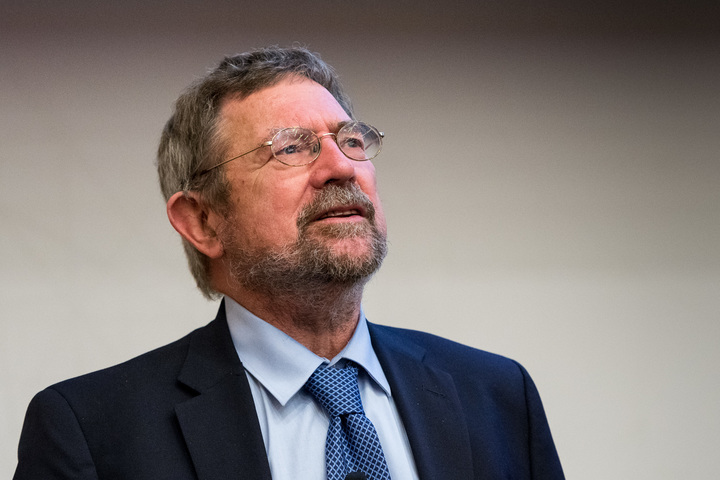By Glenn Billman, deputy campus news editor
When physicist John Michael Kosterlitz found out he had won the Nobel prize, he was on sabbatical in Finland in an underground car park on his way to get sushi and beer.
“I realized, ‘Wow, it’s actually real.’ I was completely astonished by this,” Kosterlitz said. “Long silence as I struggled to think of something to say but I couldn’t … Really, I was so amazed by this.”
Hundreds of students and faculty gathered in West Village F Friday afternoon to hear Kosterlitz speak about his path to earning the 2016 Nobel prize for his work with topological phase transitions.
The standing-room-only event kicked off with Kosterlitz describing his failed attempt to be a high energy physicist. Twice he said he had dedicated himself to a problem, and just as he finished his work, another research group based out of the University of California, Berkeley published their solution to the same problem. Kosterlitz decided he could not compete with them, and he left the field of high energy physics to work with condensed-matter physicist David Thouless, with whom he would eventually win the Nobel prize.
“I threw up my hands in disgust and said, ‘Look, I can’t compete on my own with this Berkeley group, so I got to do something about it,’” Kosterlitz said. “So I walked around the department in Birmingham, knocking on every office door and asking if anyone had a problem I could look at. Eventually I found myself in David Thouless’ office, and I ended up listening to him talking about all sorts of weird and wonderful ideas that were completely new to me.”
Kosterlitz said Thouless had a reputation of not being one to suffer fools and was a legendary physicist before he began to suffer from dementia.
“In his prime, David had the most incredible mind. Thouless basically knew everything about everything,” Kosterlitz said. “But he was never stuck in a certain way of thinking. Thouless and I were the ideal sort of people to approach a brand new problem.”
Kosterlitz, Thouless and F. Duncan M. Haldane won the 2016 physics Nobel prize for their work in discovering the Berezinskii-Kosterlitz-Thouless transition. Before the team released its research, there was no science to explain why superconductors in the shape of cylindrical wires lose their conductive abilities uniformly as they warm up, or why flat sheets become less conductive at certain points. The researchers were able to create the physics that explains why topological differences, such as a cylindrical wires versus flat sheets, transition differently.
Vadim Berezinskii, for whom the transition is named, worked independently on the conductivity issue one year before Kosterlitz and Thouless; however, his work was only published in Soviet circles.
“This is a very hard experiment to do,” Kosterlitz said. “So, the theoretical predictions and the experimental data measurements in two dimensions seemed to agree rather well. I guess one has to say this theory seems to work.”
Third-year physics major and attendee Monika Eggenberger said she was excited to hear Kosterlitz’s presentation.
“It’s a really exciting opportunity to be able to hear from someone who is not only really prevalent in the field, but who has been really prevalent in relatively recent times,” Eggenberger said. “The reason that topological materials and topology in physics are really exciting is that materials in their bulk have really different properties than materials in their surfaces and on their edges.”
Kathryn Larkin, a fourth-year biomedical engineer, also attended the speech. She said the best part of the talk was Kosterlitz’s story about his transition from high energy to topological physics.
“I found it was really inspiring how he mentioned he was in high energy physics, and then was thinking, ‘Oh, that field is moving really quickly, I don’t feel like I can contribute as much,’ and just being able to go into a different field and make incredible contributions to it,” Larkin said. “I find physics is something to study as an undergraduate is really cool because you can kind of apply it to almost any kind of science.”
Near the end of his talk, Kosterlitz told the audience the Nobel Committee first tried to reach him at his home phone number to inform him he had won the award, however only his son was home in Providence, Rhode Island. When his son answered the phone, the committee told him the reason for their call was confidential.
“He got a bit upset because he’d just been woken up at half past 5 in the morning by a phone call, and they tell you it’s secret and won’t say anything, so he just sort of snarled at them, ‘You mean you woke me up at 5 in the morning to talk about secrets?’” Kosterlitz said, miming hanging up a phone. “I heard this story from one of the members of the Nobel Foundation who had been there when the phone call was made and said that was a funny episode. It was the only time he can remember the Nobel Committee has been hung up on.”
Kosterlitz concluded his presentation by encouraging students to follow their passions and said it was not worthwhile to do something if they did not love it.
“If something turns you on and you get excited by it, go for it,” Kosterlitz said. “Why not? Have fun with it. If you’re lucky, very lucky, something wonderful might happen.”









